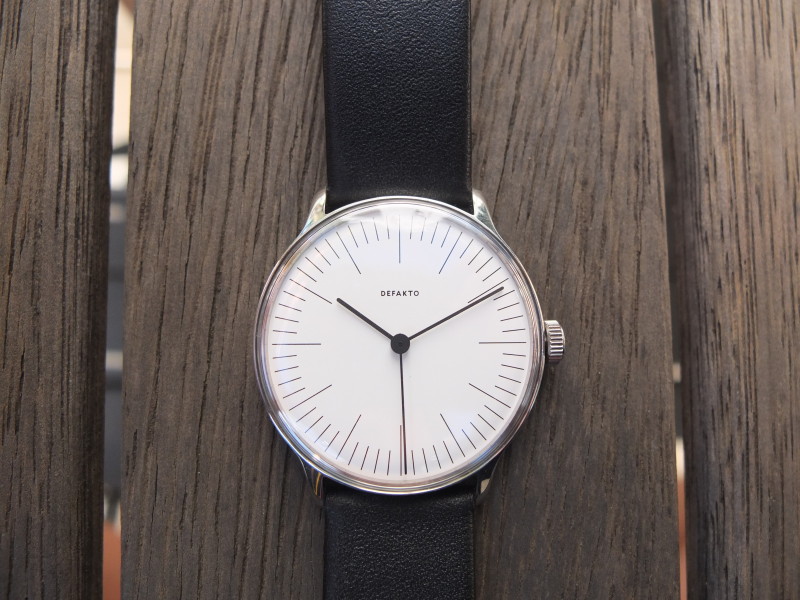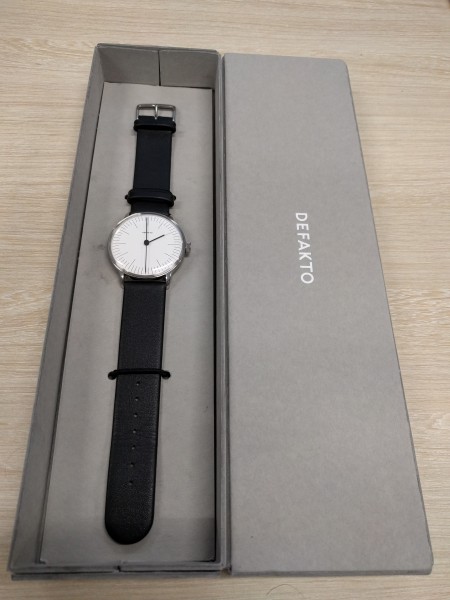At Bridge & Barrel, we are unapologetically big fans of German watches. What often comes together is a tempting value proposition combining dial quality, carefully machined cases and fantastic customer service at a reasonable price.
And this value can come at every end of the watch making spectrum. A Nomos with an in-house movement coming in under $2500 and an Archimede Pilot Chonograph with a Valjoux 7750 coming in under $1900 both provide value for different reasons.
Standing proudly with its German peers is Defakto , carrying on the strong watchmaking/casemaking lineage of the Ickler family. The Ickler family have been involved in the watch industry since 1924 and are currently involved with Defakto, Archimede and Limes.
Together we have the Defakto Vektor in for review, the newest release from the darlings of the value watch crowd. This is the first time we’ve handled a Defakto and have been looking forward to putting one through its paces for some time yet. We have the white/black dial variant, but do pop to the Defakto website to view the black/red dial variant.
The Vektor
Unsurprisingly for a bauhaus inspired dress watch, the Vektor is a watch defined by the little details. We’ve said it before and it bears repeating again, the success of a dress watch is dictated just as much as the brand’s design choices to include elements, as well as the design choices to refrain from, or exclude, other elements.
Dial
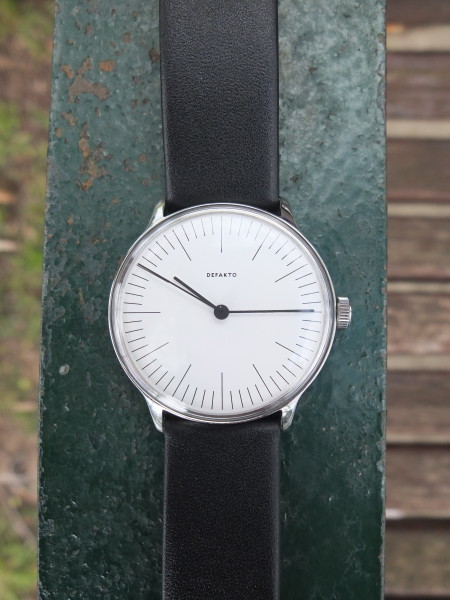 Measuring a substantial (relatively speaking) 39mm, and with a slim bezel, the Vektor’s dial has a lot of real estate. Contained within that space are few elements, but each comes across as a carefully considered choice.
Measuring a substantial (relatively speaking) 39mm, and with a slim bezel, the Vektor’s dial has a lot of real estate. Contained within that space are few elements, but each comes across as a carefully considered choice.
Firstly, the dial is a simple matte, oh-so-slightly-just off white tone. It falls short of being warm, but isn’t plain or boring.
In terms of branding, a simple DEFAKTO in small font bisects the distance between the centre of the dial and the outer limit of the 12 o’clock marker. No other branding or information is included on the dial. Most similar watches include some additional amount of dial text or a small seconds subdial, but the Vektor foregoes these for an even more pared-back aesthetic. I found the lack of additional branding or dial text as being in keeping with the Vektor’s industrial aesthetic and was relieved it didn’t create a dial imbalance (largely a result of the small DEFAKTO font).
The chapter ring incorporates only long and thin printed hour markers and smaller (just under half the length) printed minute markers. The hour markers extend almost half the distance to the centre of the dial. Initially I was concerned about the amount of negative space generated by the dial size and limited elements, but the additional length of the hour markers balances the design well.
There is no relief, in the form of text, sub-seconds or a date, to break up the consistent tread of hour and minute markers. Nor does the 12 o’clock marker differ from any of the others to provide a separate reference point. The consistency is almost relentless, and it is interesting that the Vektor’s design doesn’t give in to providing additional flourishes or more playful elements. It comes across as a serious watch (if a watch can ever be a “serious” watch).
The dial has a gentle slope away radially towards the wrist, following a similar doming as the acrylic crystal. Following this gradient are the hand-bent hands, which also slope down with the dial. While the tolerances between the acrylic crystal, handset and dial would likely have been large enough to allow for a flat dial or unbent hands, the combination of the three elements together creates a simple design cohesion.
The crystal doesn’t have AR coating, but I didn’t have any legibility issues with the Vektor.
The handset is a combination of matte black stick hands (rather than black lacquer sometimes found on similar models), which continues the serious vibe to the Vektor. The second hand is slightly thinner and longer than its minute counterpart, and, if you’re only quickly glancing at the watch, the similarity between the second and minute hands may be deceptive. I’ve always found that I look/stare at my watches long enough to pick up second hand movement (the Miyota beating at 4 Hz should be enough) and adjust my focus, so for me this wasn’t ever an issue.
Like the dial, there’s no lume on the handset. This fairly true to form for a Bauhaus and industrial inspired watch, but it might detract from its ability as an everyday, all occasion, watch. The Vektor could be an everyday watch for someone that enjoys the Bauhaus/industrial aesthetic, but the lack of dial or hand lume might be a deal breaker in this day/night versatility equation.
 The extremities of the hands create some interesting design details. As mentioned I touched on earlier, the hands are hand bent to follow the shape of the dial and the crystal. At the centre of the dial each hand ends in a black matte circle that connects the hands to the dial and movement. It is a simple element, but reminds me of the cap for the hand of a car speedometer. It is a strange connection to make (and outside of the traditional Bauhaus aesthetic) but aides the tool/instrument vibe of the watch.
The extremities of the hands create some interesting design details. As mentioned I touched on earlier, the hands are hand bent to follow the shape of the dial and the crystal. At the centre of the dial each hand ends in a black matte circle that connects the hands to the dial and movement. It is a simple element, but reminds me of the cap for the hand of a car speedometer. It is a strange connection to make (and outside of the traditional Bauhaus aesthetic) but aides the tool/instrument vibe of the watch.
(photo from here)
Case
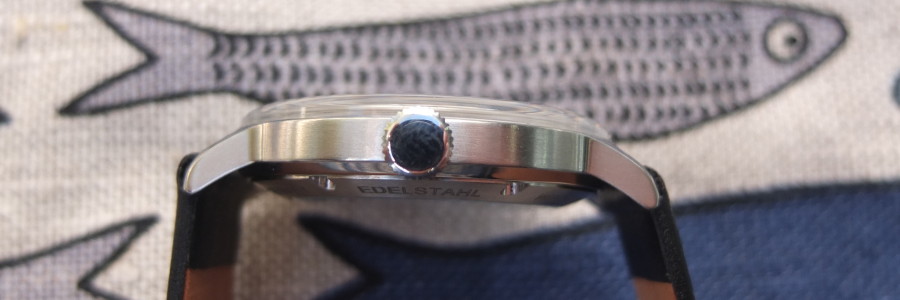 Unlike other Bauhaus/industrial inspired watches which cases and lugs typically showcase rigid and unyielding lines, the Vektor has a comparatively flowing style. This is largely by reason of the short lugs with substantial curve towards the wrist. These lugs are incorporated moreso aesthetically into the case than in other similar watches, which allows the case to run in at 39mm, but have a 43mm lug-to-lug length. The short lugs also bring the strap closer to the case, eliminating the case/strap gap that can be a bugbear for some.
Unlike other Bauhaus/industrial inspired watches which cases and lugs typically showcase rigid and unyielding lines, the Vektor has a comparatively flowing style. This is largely by reason of the short lugs with substantial curve towards the wrist. These lugs are incorporated moreso aesthetically into the case than in other similar watches, which allows the case to run in at 39mm, but have a 43mm lug-to-lug length. The short lugs also bring the strap closer to the case, eliminating the case/strap gap that can be a bugbear for some.
The case is a simple two-piece construction with a screw down caseback and virtually no topside bezel. Topside the lugs are tastefully polished and the midcase adopts a simple brushed finish. It’s by no means a complex and involved case construction but the Ickler quality does comes through. A 30m water resistance protects the Vektor from splashes and rain, but it won’t be following you to the depths (hopefully!).
In terms of the crown, it is completely unadorned and comes in a simple pillbox push-pull variety. I’ve never been someone that takes a lot of notice of crown branding, but now that there is none on the Vektor, I find myself thinking that its absence may be a missed opportunity. In this particular model, the crown was a bit cushy and didn’t have a super noticeable detent to identify the change from hand-winding to hand setting, but this may be limited just to the review model.
Running in at 39mm, the Vektor provides an interesting alternative from some of the other mainstays in the Bauhaus world. Many Nomos and the like pieces run between 35-38mm, which do sometimes run the risk of criticism for not being in touch with modern sizing. While I actually prefer watches running around that size, the Vektor was certainly a comfortable wear, never unwieldy and wears similarly.
Movement
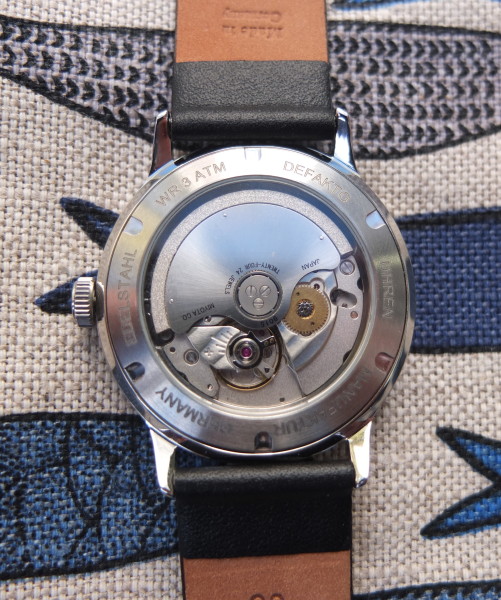 I’ve had enough experience with the Miyota 9015 to appreciate that it’s a fairly robust and reliable movement, and as with previous watches with the same movement, I’ve had no issues here. As you will no doubt know, it won’t win too many hearts in the beauty stakes, but I (and a veritable menagerie of people from “one watch fits all” people to enthusiasts) do enjoy being able to view the beating heart of a watch from the clear caseback on the Vektor. In terms of design cohesion, a solid caseback would have been more appropriate, but I’m willing to give the Vektor a pass for this one.
I’ve had enough experience with the Miyota 9015 to appreciate that it’s a fairly robust and reliable movement, and as with previous watches with the same movement, I’ve had no issues here. As you will no doubt know, it won’t win too many hearts in the beauty stakes, but I (and a veritable menagerie of people from “one watch fits all” people to enthusiasts) do enjoy being able to view the beating heart of a watch from the clear caseback on the Vektor. In terms of design cohesion, a solid caseback would have been more appropriate, but I’m willing to give the Vektor a pass for this one.
It bears repeating again that the price of the movement does not need to directly correlate with the price of a watch. There are cheaper ETA based watches than those from Tudor, but there remains a value proposition in the Tudor brand. Similarly, a cheaper Miyota 9015 can be found on the market, but the 537 Euro (without VAT) is a fair price for the Vektor with the Miyota equipped.
Strap
The 20mm, straight cut, unstitched cowhide strap a very simple affair. I wasn’t particularly disappointed or impressed by the strap, but was pleased to see DEFAKTO engraved onto the buckle.
The hand made box is a nice touch too.
Conclusion
The Vektor provides a compelling value proposition. There is a gap in the market between the $100-200 fashion watches that are minimalist inspired (if you’re into thank kind of thing – no judgement) and the likes of Junghans, Stowa and Nomos releasing Bauhaus influenced pieces running you 800+ Euro (and much more). Not that the Vektor is the poor cousin to these (it certainly pulls its weight), but at a 537 Euro pricepoint, it is hard to beat.


